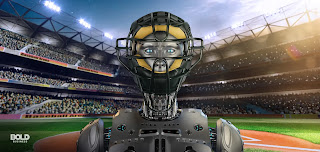MLB and AI: Tradition vs Innovation
Major League Baseball (MLB) is the longest running professional sports league in America dating back to 1876. Trying to hold on to its "old-school" image has been a priority, however, the game is no stranger to innovation as it has had to do so to maintain relevance over the past 135 years. According to chicagostylesports.com, it appears now that MLB is on the verge of its latest major innovation. An innovation that will, for the first time ever, merge the old-school ideals of traditional baseball with the new-school artificial intelligence information that is seeing more and more use in sports as we improve our understanding of the technology. I present to you: The Robot Umpire (or RoboUmp for short).
 |
| Photo Source: Chicagostylesports.com |
The image shown above is, of course, completely satirical in nature. MLB is not at all concerned with replacing home plate umpires with actual robots. As a matter of fact, the game would "look" the exact same as it does now. This to the extent of fans that were unaware that roboumps were being used, would never find out unless they were told. This is due to how MLB plans to implement them, which is by having the home plate umpire wear earbuds to which the roboump will announce the call (whether it is a ball or strike) of the most recent pitch to the umpire, and then the umpire would announce that call to everyone else, per axios.com. An important note here is that the roboump would be solely used for determining whether pitches are balls or strikes, and would not be responsible for any other calls a home plate umpire would make such as check swings, plays at the plate, and interference.
While there is no public documentation on how the code for roboumps work (at least none I could find in a quick Google search), I could only assume it has to do with many precisely aimed and well coded cameras combined with a program that checks for a spherical object crossing into the "strike-zone". One argument for roboumps working better than human umpires is that roboumps are able to view and interpret the strike zone as a three dimensional box. This contrasted with human umpires who are really only able to see a two dimensional view of the strike zone because they are not able to take one eyeball out and dangle it above the batters box to watch the depth aspect of the strike zone. Another minor advantage of roboumps is that the strike zone is not constant, the top and bottom are actually unique to each hitter due to the fact that it is based on the hitter's knee and middle-abdomen locations as pictured below. While human umpires have always done there best to fairly zone all players, roboumps would guarantee that each player had correct dimensions of their strike zone.
 |
| Photo Source: Baseballtrainingworld.com |
To many casual baseball fans, this may sound like a no brainer. Why wouldn't you want to have a perfectly accurate pitch caller; especially compared to a human home plate umpire to whom they appear to be getting worse and worse at accurately calling balls and strikes with each season that passes? According to thenewstack.io, what seems like a simple choice actually has a lot of controversy behind it. To understand this, it must first be understood that longtime baseball fans are stubborn. They do not like change, and when looking at their age demographics, they also are not the biggest fans of new technology. AKA a very large portion of MLB's fanbase are stubborn old men. If you can't teach an old dog new tricks, then you definitely can't teach an old baseball fan to accept changes to their favorite game. So who's right here?
Me being a lifelong baseball fan as well as an advocate for new technologies, I can see arguments for both sides. In my opinion, it is much easier to see the arguments for the roboumps, especially for casual or non-fans. In a nutshell it comes down to perfect robot pitch calling versus fairly accurate human pitch calling, and in that battle, roboumps win 10 times out of 10. As for the non-roboump side, you have to dig a little further or know a little more about baseball to find their argument, but it still may hold. The main argument for their side is while yes, inaccurate pitch calls have cost great teams, great players, and great coaches chances at winning it all, it is this human inaccuracy that truly makes the game interesting and exciting. Without inaccuracy, it takes away many of the greatest "What-if?" scenarios in MLB history that fans love to chat and theorize about. On top of that, MLB has made it 135 years using human umpires the entire time, why change now?
While there may not be a definitive answer to this argument yet, MLB is doing its best to make both sides happy. Starting a few years ago, the MLB decided to fully implement roboumps as well as other new school rule changes to some select minor league divisions for testing. The results from these tests are still being calculated, but at the very least we can see that MLB is making an effort to be innovative even with over half of the current fans favoring the old school way. In my opinion, roboumps are inevitable especially with the high alert now on human home plate umpires, and with that high alert has come more programs than ever to track how many pitches human umpires are calling inaccurately (and oh boy, it's a lot). Perhaps once sophisticated enough, AI technology could be a commonality in sports like as out-of-bounds or offsides trackers for sports like tennis or soccer, respectively. However, for now, it must pass the baseball test, and more importantly for any sport's implementation of new AI technology, it must be accepted by the fans.
